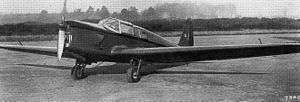Comper Mouse
| Mouse | |
|---|---|
 | |
| Role | Three-seat cabin monoplane |
| National origin | United Kingdom |
| Manufacturer | Comper Aircraft Company |
| Designer | Nicholas Comper |
| First flight | 11 September 1933 |
| Retired | 1935 |
| Number built | 1 |
|
| |
The Comper Mouse was a 1930s British three-seat cabin monoplane designed by Nicholas Comper, and built by the Comper Aircraft Company at Heston Aerodrome in 1933.
Development
The Mouse was a low-wing monoplane touring aircraft, powered by a 130 hp (97 kW) de Havilland Gipsy Major piston engine. Construction was mainly of fabric-covered spruce wood frames, with some plywood-covered sections. It had folding wings, retractable main landing gear and fixed tailskid. Accommodation was for the pilot and two passengers, accessible via a sliding framed canopy, plus an additional luggage locker. The first flight of the Mouse was at Heston aerodrome on 11 September 1933, piloted by Nick Comper. In February 1934, it was assessed at A&AEE Martlesham Heath, leading to various small design changes[1][2][3]
Operational history
On 13–14 July 1934, the Mouse (registered G-ACIX) was flown by E.H. Newman in handicapped heats for the King's Cup Race at Hatfield Aerodrome in poor weather conditions. It failed to reach the final race, despite an average speed of 132.75 mph. In an already competitive market for touring aircraft, the Mouse failed to attract sales, and only the one was completed before the company ceased trading in August 1934.[1][4]
Specifications
Data from Meaden (2005)[2]
General characteristics
- Crew: 1 (pilot)
- Capacity: 2 passengers
- Length: 25 ft 1 in (7.65 m)
- Wingspan: 37 ft 6 in (11.43 m)
- Height: 6 ft 9 in (2.05 m)
- Wing area: 172 ft2 (16 m2)
- Empty weight: 1300 lb (590 kg)
- Gross weight: 2215 lb (1005 kg)
- Powerplant: 1 × de Havilland Gipsy Major piston engine, 130 hp (97 kW)
Performance
- Maximum speed: 135 mph (217 km/h)
- Cruise speed: 130 mph (209 km/h)
- Range: 600 miles (965 km)
Notes
References
- Boughton, Terence. 1963. The Story of The British Light Aeroplane. John Murray
- Jackson, A.J. (1974). British Civil Aircraft since 1919 Volume 2. London: Putnam. ISBN 0-370-10010-7.
- Lewis, Peter. 1970. British Racing and Record-Breaking Aircraft. Putnam ISBN 0-370-00067-6
- Meaden, Jack & Fillmore, Malcolm. (Summer 2005). The Comper Lightplanes. Air-Britain Archive (quarterly). Air-Britain. ISSN 0262-4923
- Riding, Richard T. 1987. Ultralights: The Early British Classics. Patrick Stephens ISBN 0-85059-748-X
- Riding, Richard T. June 1988. British Pre-war Lightplanes No.1: Comper Mouse. Aeroplane Monthly. IPC Media
- Riding, Richard T. March 2003. Database: Comper Swift. Aeroplane Monthly. IPC Media
- Smith, Ron. 2002. British Built Aircraft Vol.1: Greater London ISBN 0-7524-2770-9
External links
| Wikimedia Commons has media related to Comper Mouse. |